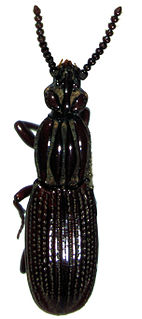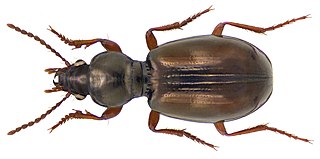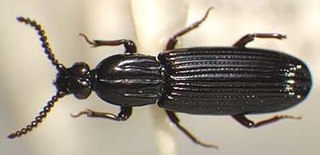
Ground beetles are a large, cosmopolitan family of beetles, the Carabidae, with more than 40,000 species worldwide, around 2,000 of which are found in North America and 2,700 in Europe. As of 2015, it is one of the 10 most species-rich animal families.

Rhysodidae is a family of beetles, consisting of more than 350 species in about 20 genera.

Miscodera arctica is a species of beetles in the family Carabidae, the only species in the genus Miscodera. It is circumpolar in distribution, predominantly northern, with outliers in New Hampshire and Maine in the continental U.S. Its relationships have been long disputed. Here it is placed in subfamily Broscinae. While it certainly belongs to the more advanced ground beetles, it was alternatively placed in the subfamily Trechinae.
Rhysodinae is a subfamily of wrinkled bark beetles in the family Carabidae. The group of genera making up Rhysodinae has been treated as the family Rhysodidae in the past, and DNA analysis has more recently supported treating it as the tribe Rhysodini.

Clinidium is a genus of wrinkled bark beetles in the family Carabidae. Most species are Neotropical, but some occur further north in North America and there is also one species in Europe and one in Japan. Two species are known from Miocene amber.
Grouvellina is a genus of beetles in the family Carabidae, containing the following species:

Rhyzodiastes is a genus of beetles in the family Carabidae, containing the following species:

Dhysores is a genus of beetles in the family Carabidae, containing the following species:
Tangarona is a genus of wrinkled bark beetles in the family Carabidae. Tangarona pensa, found in New Zealand, is the only species of this genus.
Arrowina is a genus of wrinkled bark beetles in the family Carabidae, containing the following species:

Omoglymmius is a genus of wrinkled bark beetles in the family Carabidae, found on every continent except Africa and Antarctica. There are at least 150 species in Omoglymmius.
Shyrodes is a genus of wrinkled bark beetles in the family Carabidae. There are at least two described species in Shyrodes.

Kaveinga is a genus of wrinkled bark beetles in the family Carabidae, containing the following species:
Sloanoglymmius is a genus of wrinkled bark beetles in the family Carabidae. Sloanoglymmius planatus, found in Australia, is the only species of this genus.

Omoglymmius batantae is a species of beetle in the subfamily Rhysodidae. It was described by R.T. & J.R. Bell in 2009.
Clinidium segne is a species of ground beetle in the subfamily Rhysodinae. It was described by R.T. Bell & J.R. Bell in 1985. It is known from the Aragua state in northern Venezuela. Clinidium segne females measure 4.6–5.2 mm (0.18–0.20 in) in length.
Rhyzodiastes burnsi is a species of ground beetle in the subfamily Rhysodinae. It was described by Charles G. Oke in 1932. It is found in Australia; the type locality is Mount Wilson, New South Wales. Rhyzodiastes burnsi measure 7 mm (0.28 in) in length.
Kaveinga walfordi is a species of ground beetle in the subfamily Rhysodinae. It was described by R.T. & J.R. Bell in 1992. It is found in eastern Queensland, Australia.

Ross Taylor Bell was an American entomologist with particular interest in the invertebrate natural history of Vermont, United States, and carabid beetles. Together with his wife, Joyce Bell, his work at the University of Vermont was largely taxonomic, where they described more than 75% of the rhysodine species known to science. Ross also wrote a number of seminal papers in his chosen field.

Rhysodini is a tribe of wrinkled bark beetles in the family Carabidae. There are about 19 genera and at least 380 described species in Rhysodini.









